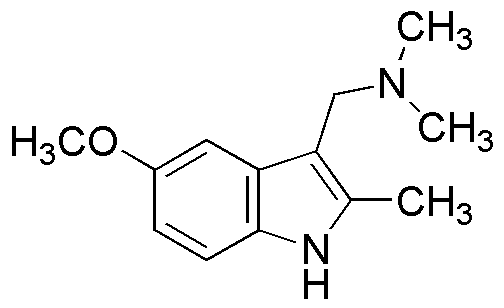5-Methoxy-2-methylgramine is widely utilized in research focused on:
- Pharmaceutical Development: This compound is being explored for its potential therapeutic effects, particularly in the treatment of neurological disorders. Researchers are investigating its ability to modulate neurotransmitter systems.
- Plant Growth Regulation: In agricultural science, it is being tested as a growth regulator that can enhance crop yield and resilience, helping farmers improve productivity sustainably.
- Biochemical Research: It serves as a valuable tool in biochemical assays, aiding scientists in understanding complex biological pathways and interactions at the molecular level.
- Natural Product Synthesis: The compound is used in organic synthesis as a building block for creating more complex molecules, which can lead to the development of new materials or drugs.
- Analytical Chemistry: It is employed in various analytical techniques to detect and quantify other substances, providing researchers with essential data for their studies.
General Information
Properties
Safety and Regulations
Applications
5-Methoxy-2-methylgramine is widely utilized in research focused on:
- Pharmaceutical Development: This compound is being explored for its potential therapeutic effects, particularly in the treatment of neurological disorders. Researchers are investigating its ability to modulate neurotransmitter systems.
- Plant Growth Regulation: In agricultural science, it is being tested as a growth regulator that can enhance crop yield and resilience, helping farmers improve productivity sustainably.
- Biochemical Research: It serves as a valuable tool in biochemical assays, aiding scientists in understanding complex biological pathways and interactions at the molecular level.
- Natural Product Synthesis: The compound is used in organic synthesis as a building block for creating more complex molecules, which can lead to the development of new materials or drugs.
- Analytical Chemistry: It is employed in various analytical techniques to detect and quantify other substances, providing researchers with essential data for their studies.
Documents
Safety Data Sheets (SDS)
The SDS provides comprehensive safety information on handling, storage, and disposal of the product.
Product Specification (PS)
The PS provides a comprehensive breakdown of the product’s properties, including chemical composition, physical state, purity, and storage requirements. It also details acceptable quality ranges and the product's intended applications.
Certificates of Analysis (COA)
Search for Certificates of Analysis (COA) by entering the products Lot Number. Lot and Batch Numbers can be found on a product’s label following the words ‘Lot’ or ‘Batch’.
*Catalog Number
*Lot Number
Certificates Of Origin (COO)
This COO confirms the country where the product was manufactured, and also details the materials and components used in it and whether it is derived from natural, synthetic, or other specific sources. This certificate may be required for customs, trade, and regulatory compliance.
*Catalog Number
*Lot Number
Safety Data Sheets (SDS)
The SDS provides comprehensive safety information on handling, storage, and disposal of the product.
DownloadProduct Specification (PS)
The PS provides a comprehensive breakdown of the product’s properties, including chemical composition, physical state, purity, and storage requirements. It also details acceptable quality ranges and the product's intended applications.
DownloadCertificates of Analysis (COA)
Search for Certificates of Analysis (COA) by entering the products Lot Number. Lot and Batch Numbers can be found on a product’s label following the words ‘Lot’ or ‘Batch’.
*Catalog Number
*Lot Number
Certificates Of Origin (COO)
This COO confirms the country where the product was manufactured, and also details the materials and components used in it and whether it is derived from natural, synthetic, or other specific sources. This certificate may be required for customs, trade, and regulatory compliance.


